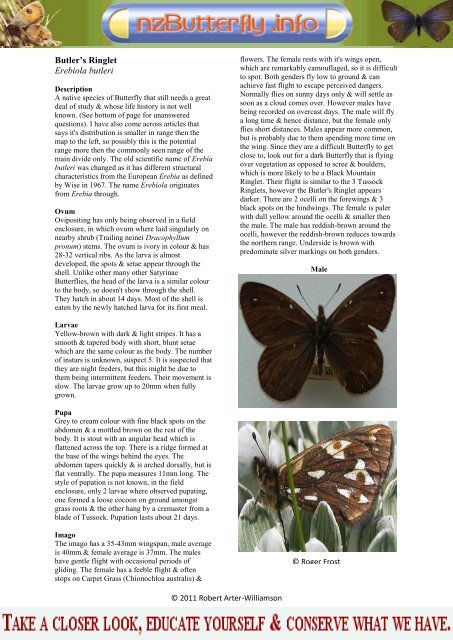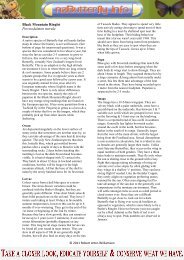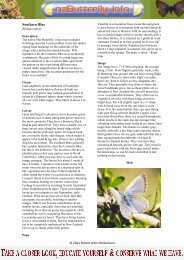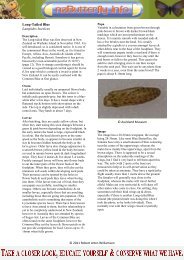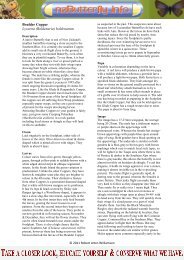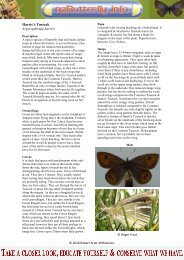Butler's Ringlet Erebiola butleri - NZ Butterfly Info
Butler's Ringlet Erebiola butleri - NZ Butterfly Info
Butler's Ringlet Erebiola butleri - NZ Butterfly Info
Create successful ePaper yourself
Turn your PDF publications into a flip-book with our unique Google optimized e-Paper software.
Butler’s <strong>Ringlet</strong><strong>Erebiola</strong> <strong>butleri</strong>DescriptionA native species of <strong>Butterfly</strong> that still needs a greatdeal of study & whose life history is not wellknown. (See bottom of page for unansweredquestions). I have also come across articles thatsays it's distribution is smaller in range then themap to the left, so possibly this is the potentialrange more then the commonly seen range of themain divide only. The old scientific name of Erebia<strong>butleri</strong> was changed as it has different structuralcharacteristics from the European Erebia as definedby Wise in 1967. The name <strong>Erebiola</strong> originatesfrom Erebia through.OvumOvipositing has only being observed in a fieldenclosure, in which ovum where laid singularly onnearby shrub (Trailing neinei Dracophyllumpronum) stems. The ovum is ivory in colour & has28-32 vertical ribs. As the larva is almostdeveloped, the spots & setae appear through theshell. Unlike other many other SatyrinaeButterflies, the head of the larva is a similar colourto the body, so doesn't show through the shell.They hatch in about 14 days. Most of the shell iseaten by the newly hatched larva for its first meal.flowers. The female rests with it's wings open,which are remarkably camouflaged, so it is difficultto spot. Both genders fly low to ground & canachieve fast flight to escape perceived dangers.Normally flies on sunny days only & will settle assoon as a cloud comes over. However males havebeing recorded on overcast days. The male will flya long time & hence distance, but the female onlyflies short distances. Males appear more common,but is probably due to them spending more time onthe wing. Since they are a difficult <strong>Butterfly</strong> to getclose to, look out for a dark <strong>Butterfly</strong> that is flyingover vegetation as opposed to scree & boulders,which is more likely to be a Black Mountain<strong>Ringlet</strong>. Their flight is similar to the 3 Tussock<strong>Ringlet</strong>s, however the <strong>Butler's</strong> <strong>Ringlet</strong> appearsdarker. There are 2 ocelli on the forewings & 3black spots on the hindwings. The female is palerwith dull yellow around the ocelli & smaller thenthe male. The male has reddish-brown around theocelli, however the reddish-brown reduces towardsthe northern range. Underside is brown withpredominate silver markings on both genders.MaleLarvaeYellow-brown with dark & light stripes. It has asmooth & tapered body with short, blunt setaewhich are the same colour as the body. The numberof instars is unknown, suspect 5. It is suspected thatthey are night feeders, but this might be due tothem being intermittent feeders. Their movement isslow. The larvae grow up to 20mm when fullygrown.PupaGrey to cream colour with fine black spots on theabdomen & a mottled brown on the rest of thebody. It is stout with an angular head which isflattened across the top. There is a ridge formed atthe base of the wings behind the eyes. Theabdomen tapers quickly & is arched dorsally, but isflat ventrally. The pupa measures 11mm long. Thestyle of pupation is not known, in the fieldenclosure, only 2 larvae where observed pupating,one formed a loose cocoon on ground amongstgrass roots & the other hang by a cremaster from ablade of Tussock. Pupation lasts about 21 days.ImagoThe imago has a 35-43mm wingspan, male averageis 40mm & female average is 37mm. The maleshave gentle flight with occasional periods ofgliding. The female has a feeble flight & oftenstops on Carpet Grass (Chionochloa australis) &© Roger Frost© 2011 Robert Arter-Williamson
FemaleDistributionHabitatDamp (almost boggy) terraces of alpine scrub &Snow tussock from 900-1300m.Food PlantsThis is not known at present, however final instarlarvae have being spotted feeding on SnowTussock (Chionochloa spp) until pupation, but firstinstar larvae refuse to eat this plant. First instarlarvae have being tested on Blue Tussock Grass(Poa colensoi) & also refused to eat that as well.But they did eat various lawn grasses. I suspect thatsince the females like to stop frequently on CarpetGrass (Chionochloa australis) they maybeovipositing or checking for suitable nearbyovipositing locations. However, this is just a theoryas I have no proof of this.StatusRare - Alpine grasslands from Nelson to Otago,including Fiordland, Paparoa ranges & mountainseast of Lake Hawea. Can become very common inlocal areas.PhenologyNote: there is no published information forlifecycle of this species. I would guess eggs arepresent in March, but who knows beyond that.CopyrightAll content belongs to Robert Arter-Williamsonand www.nzbutterfly.info.Factsheet Design lay out by Stuart Desjardins.© 2011 Robert Arter-Williamson


